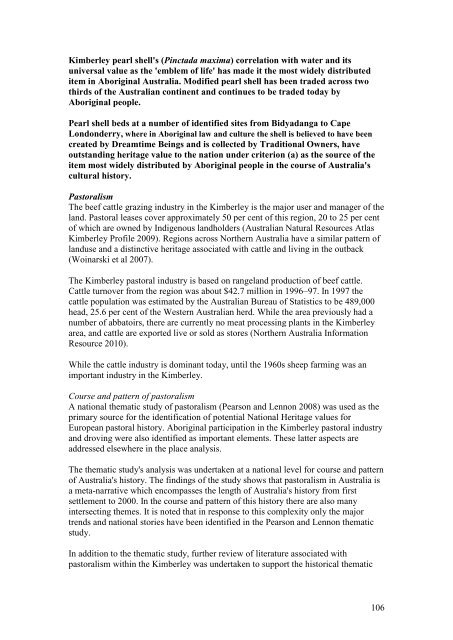WEST KIMBERLEY PLACE REPORT - Department of Sustainability ...
WEST KIMBERLEY PLACE REPORT - Department of Sustainability ...
WEST KIMBERLEY PLACE REPORT - Department of Sustainability ...
You also want an ePaper? Increase the reach of your titles
YUMPU automatically turns print PDFs into web optimized ePapers that Google loves.
Kimberley pearl shell's (Pinctada maxima) correlation with water and its<br />
universal value as the 'emblem <strong>of</strong> life' has made it the most widely distributed<br />
item in Aboriginal Australia. Modified pearl shell has been traded across two<br />
thirds <strong>of</strong> the Australian continent and continues to be traded today by<br />
Aboriginal people.<br />
Pearl shell beds at a number <strong>of</strong> identified sites from Bidyadanga to Cape<br />
Londonderry, where in Aboriginal law and culture the shell is believed to have been<br />
created by Dreamtime Beings and is collected by Traditional Owners, have<br />
outstanding heritage value to the nation under criterion (a) as the source <strong>of</strong> the<br />
item most widely distributed by Aboriginal people in the course <strong>of</strong> Australia's<br />
cultural history.<br />
Pastoralism<br />
The beef cattle grazing industry in the Kimberley is the major user and manager <strong>of</strong> the<br />
land. Pastoral leases cover approximately 50 per cent <strong>of</strong> this region, 20 to 25 per cent<br />
<strong>of</strong> which are owned by Indigenous landholders (Australian Natural Resources Atlas<br />
Kimberley Pr<strong>of</strong>ile 2009). Regions across Northern Australia have a similar pattern <strong>of</strong><br />
landuse and a distinctive heritage associated with cattle and living in the outback<br />
(Woinarski et al 2007).<br />
The Kimberley pastoral industry is based on rangeland production <strong>of</strong> beef cattle.<br />
Cattle turnover from the region was about $42.7 million in 1996–97. In 1997 the<br />
cattle population was estimated by the Australian Bureau <strong>of</strong> Statistics to be 489,000<br />
head, 25.6 per cent <strong>of</strong> the Western Australian herd. While the area previously had a<br />
number <strong>of</strong> abbatoirs, there are currently no meat processing plants in the Kimberley<br />
area, and cattle are exported live or sold as stores (Northern Australia Information<br />
Resource 2010).<br />
While the cattle industry is dominant today, until the 1960s sheep farming was an<br />
important industry in the Kimberley.<br />
Course and pattern <strong>of</strong> pastoralism<br />
A national thematic study <strong>of</strong> pastoralism (Pearson and Lennon 2008) was used as the<br />
primary source for the identification <strong>of</strong> potential National Heritage values for<br />
European pastoral history. Aboriginal participation in the Kimberley pastoral industry<br />
and droving were also identified as important elements. These latter aspects are<br />
addressed elsewhere in the place analysis.<br />
The thematic study's analysis was undertaken at a national level for course and pattern<br />
<strong>of</strong> Australia's history. The findings <strong>of</strong> the study shows that pastoralism in Australia is<br />
a meta-narrative which encompasses the length <strong>of</strong> Australia's history from first<br />
settlement to 2000. In the course and pattern <strong>of</strong> this history there are also many<br />
intersecting themes. It is noted that in response to this complexity only the major<br />
trends and national stories have been identified in the Pearson and Lennon thematic<br />
study.<br />
In addition to the thematic study, further review <strong>of</strong> literature associated with<br />
pastoralism within the Kimberley was undertaken to support the historical thematic<br />
106
















